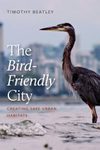About this book
The contributors to Resilience in Ecology and Urban Design propose strategies of urgent and vital importance that aim to make today's urban environments more resilient. Resilience, the ability of complex systems to adapt to changing conditions, is a key frontier in ecological research and is especially relevant in creative urban design, as urban areas exemplify complex systems. With something approaching half of the world's population now residing in coastal urban zones, many of which are vulnerable both to floods originating inland and rising sea levels, making urban areas more robust in the face of environmental threats must be a policy ambition of the highest priority. The complexity of urban areas results from their spatial heterogeneity, their intertwined material and energy fluxes, and the integration of social and natural processes. All of these features can be altered by intentional planning and design. The complex, integrated suite of urban structures and processes together affect the adaptive resilience of urban systems, but also presupposes that planners can intervene in positive ways. As examples accumulate of linkage between sustainability and building/landscape design, such as the Shanghai Chemical Industrial Park and Toronto's Lower Don River area, Resilience in Ecology and Urban Design unites the ideas, data, and insights of ecologists and related scientists with those of urban designers. It aims to integrate a formerly atomized dialog to help both disciplines promote urban resilience.
Contents
Dedication
Foreword Richard T.T. Forman
Acknowledgements
Introduction: Developing a Metalogue: Ecology, Society and Design S.T.A. Pickett, M.L. Cadenasso, and Brian P. McGrath
Section I: Ecology, Design, and Social Contexts: Disciplinary Voices and History
Chapter 1: Ecology of the City as a Bridge to Urban Design S.T.A. Pickett, M.L. Cadenasso, and Brian P. McGrath
Chapter 2: Three Tides: The Development and State of the Art of Urban Ecological Science M.L. Cadenasso and S.T.A. Pickett
Chapter 3: Social Dynamics and Sustainable Urban Design Christopher G. Boone
Chapter 4: Integral Urbanism: A Context for Urban Design Nan Ellin
Chapter 5: Landscape as Method and Medium for the Ecological Design of Cities Joan Nassauer
Section II. Shared Conceptual Understanding: Four Themes for Bridging Ecology and Urban Design
Theme 1: Spatial Heterogeneity in Ecology and Urban Design
Chapter 6: Ecological Heterogeneity in Urban Ecosystems: Reconceptualized Land Cover Models as a Bridge to Urban Design M.L. Cadenasso, S.T.A. Pickett, Brian P. McGrath, and Victoria Marshall
Chapter 7: Urban Patch Dynamics and Resilience: Three London Urban Design Ecologies D. Grahame Shane
Theme 2: Flux of Water in the Urban Realm
Chapter 8: Eco-engineering for Water: From Soft to Hard & Back Kelly Shannon
Chapter 9: Beyond Restoration and into Design: Hydrologic Alterations in Aridland Cities Elisabeth K. Larson, Stevan Earl, Elizabeth M. Hagen, Rebecca Hale, Hilairy Hartnett, Michelle McCrackin, Melissa McHale, and Nancy B. Grimm
Theme 3: Resilience: Adaptation and Change in Urban Systems
Chapter 10: Ecological Resilience as a Foundation for Urban Design and Sustainability Jianguo Wu and Tong Wu
Chapter 11: Slow, Moderate, Fast: Urban Adaptation and Change Brian P. McGrath
Theme 4: Social Actors and Agents of Urban Organization
Chapter 12: Anchoring a Terrain: Landscapes beyond Urbanism Dilip da Cunha
Chapter 13: Storyline and Design: How Civic Stewardship Shapes Urban Design in New York City Erika S. Svendsen
Chapter 14: Eco-cities without Ecology: Constructing Ideologies, Valuing Nature Julie Sze and Gerardo Gambirazzio
Section III. Bridging Ecology and Urban Design Practice
Chapter 15: Sponge City Ignacio F. Bunster-Ossa
Chapter 16: Civic Space in Regional Frameworks: Resilient Approaches to Urban Design Jill Desimini
Chapter 17: Aesthetic Resilience Victoria Marshall with Christina Tague
Chapter 18: Anchoring Philadelphia Anuradha Mathur and Dilip da Cunha
Chapter 19: Shanghai Chemical Industrial Park Treatment Wetland: Integrated Strategies in Natural Treatment System Design Kerry Rubin and Rowan Roderick-Jones
Chapter 20: Just Ground: A Social Infrastructure for Urban Landscape Regeneration Julie Bargmann
Chapter 21: Ecological and Social Linkages in Urban Design Projects: A Synthesis J. Morgan Grove
Section IV. Urban Design in Expanded Disciplinary and Geographical Contexts
Chapter 22: The Design Process as a Framework for Collaboration between Ecologists and Designers Alexander J. Felson
Chapter 23: Remixing Messages: A Call for Collaboration between Artists and Scientists Mary Miss
Chapter 24: Landscape Urbanism: A North American Perspective Alissa North and Charles Waldheim
Chapter 25: Urbanism and Ecological Rationality Paola Vigano
Chapter 26: Bangkok: The Ecology and Design of an Aqua-City Danai Thaitakoo, Brian McGrath, Suebsiri Srithanyarat, and Ying Palopakon
Chapter 27: Disturbanism in the South Pacific: Disturbance Ecology as a Basis for Urban Resilience in Small Island States Rod Barnett and Jacqueline Margetts
Chapter 28: The Ecology of the Metacity: Shaping the Dynamic, Patchy, Networked, and Adaptive Cities of the Future S.T.A.Pickett, Brian P. McGrath, and M.L. Cadenasso
Index
Customer Reviews

























![A4A: Architecture for Animals [English / Italian]](http://mediacdn.nhbs.com/jackets/jackets_resizer_medium/24/244049.jpg?height=150&width=113)












